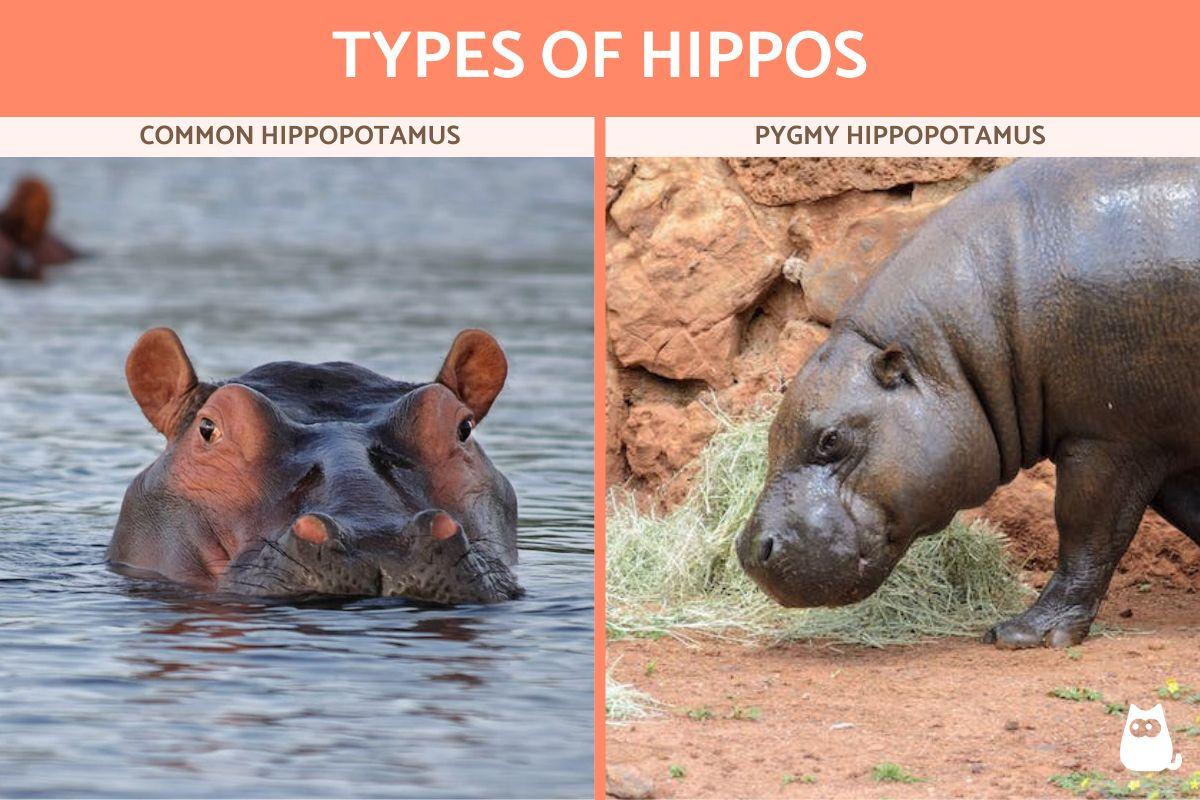How Many Types of Hippos Are There?


Hippos have undoubtedly secured their place as iconic African wildlife. Understanding the distinct types of hippos not only enriches our appreciation for biodiversity but also proves crucial for their effective conservation. By examining the unique adaptations, dietary preferences, and conservation challenges faced by each species, we gain valuable insights into the intricate tapestry of the hippopotamus family.
In this AnimalWised article, we will explore the different types of hippos, their main characteristics, and much more.
How many subspecies of hippos are there?
While the common hippopotamus (Hippopotamus amphibius) is the only recognized subspecies of its kind, the story with the pygmy hippopotamus (Choeropsis liberiensis) is a bit more intricate.
Traditionally, there were two recognized subspecies of pygmy hippopotamus: the western pygmy hippopotamus (C. l. liberiensis) and the eastern pygmy hippopotamus (C. l. liberiensis).
The Eastern pygmy hippo is slightly larger and has some minor physical differences compared to its western counterpart. However, recent genetic studies have suggested that these two populations may not be distinct enough to warrant separate subspecies classification.
Common hippopotamus (Hippopotamus amphibius)
The common hippopotamus, scientifically known as Hippopotamus amphibius, is a species native to sub-Saharan Africa. Let us take a closer look at some of its most important characteristics:
Distribution and habitat
This species is present in various countries, including Angola, Botswana, Cameroon, Chad, Ivory Coast, Congo, Ethiopia, Gabon, Gambia, Ghana, Kenya, Rwanda, Senegal, Sierra Leone, Somalia, Sudan, Malawi, Mozambique, Nigeria, Uganda, Zambia, and Zimbabwe.
Common hippos are known to inhabit wetland areas, including swamps and marshes, throughout sub-Saharan Africa. While not their primary choice, hippos may occasionally venture into estuaries where freshwater meets saltwater.
These calm waters provide the perfect environment for hippos to spend their days submerged, keeping cool and avoiding the harsh African sun.
Physical characteristics
As the largest existing species, the common hippopotamus weighs between 1.3 and 3.2 tons (2,866 to 7,055 pounds).
Measuring 2 to 5 meters in length (6.56 to 16.4 feet), including a 35 cm tail (13.8 inches), and standing at an approximate height of 1.5 to 1.6 meters (4.9 to 5.2 feet), its purplish or slate gray skin showcases a brownish-pink hue around the eyes and ears.
Noteworthy are the thick bristle-like hairs on the head and tail, while the body remains mostly hairless.
Characterized by large canine teeth reaching up to about 50 cm (19.7 inches) and incisors that can extend to 40 cm (15.7 inches), the hippopotamus can open its jaws up to 150°, showcasing formidable teeth.
Despite its immense size, the common hippopotamus is a skilled swimmer, navigating land at speeds of about 30 km/h (18.6 mph). Positioned on the top of the head, its eyes, ears, and nostrils facilitate submersion while breathing and remaining alert.
Diet
The common hippopotamus (Hippopotamus amphibius) is primarily herbivorous, meaning it predominantly consumes plant matter. Their diet consists mainly of grasses, reeds, and shoots. Despite being amphibious and spending a significant portion of their time in water during the day, they do not typically consume aquatic vegetation.
Social behavior
Hippos are social animals, and they often form groups known as herds. These herds can range from a few dozen to a hundred individuals. However, while hippos are generally social, they can also exhibit solitary behavior, especially during non-breeding periods. Solitary hippos may move around independently in search of food or suitable resting spots.
Communication among hippos involves various vocalizations, including grunts, roars, and honks. These sounds serve to convey different messages, such as warning signals, social bonding, or expressions of aggression.
Hippos are mainly nocturnal, and their social interactions often occur during the night when they come out of the water to graze and engage in various social behaviors.
Territoriality Among Males: Adult males, especially during the breeding season, display territorial behavior. Dominant males establish and defend territories in water bodies such as rivers or lakes. Younger males may be allowed in the territory as long as they are submissive.
Reproduction
Common hippos do not have a specific mating season, and mating can occur throughout the year. During the breeding season, males actively seek out females for mating. Territorial disputes among males are common during this time.
The gestation period for female hippos is around 8 months. Typically, females give birth to a single calf, although twin births are rare. Female hippos lactate for an extended period, often lasting around 18 months or more. This prolonged lactation period contributes to the care and development of the offspring.
Female hippos are protective mothers and provide care to their young. The calf stays close to its mother, and the bond between them is crucial for the calf's survival. Males do not play a direct role in parenting. After mating, they may move on to seek other mates or defend their territories.
The reproductive rate of common hippos is relatively low. Females do not reproduce every year, and the average interval between births is approximately two years.
Do not miss this other article, where we explain why hippos are dangerous.

Pygmy hippopotamus (Choeropsis liberiensis)
The Pygmy Hippopotamus, scientifically known as Choeropsis liberiensis, is a smaller and less-known relative of the common hippopotamus (Hippopotamus amphibius).
Distribution and habitat
Found primarily in Liberia, the Pygmy Hippopotamus has a limited range in West Africa. Within Liberia, its populations are densest in the western and southeastern regions. Smaller, more scattered groups also exist in Sierra Leone, Guinea, and Ivory Coast.
These creatures prefer the dense vegetation and slow-moving waters of lowland primary and secondary evergreen forests. These areas, with their winding rivers and streams, offer the perfect habitat for their shy and secretive lifestyle. Occasionally, their travels may take them through gallery forests that border savanna regions.
Physical characteristics
Weighing between 160 to 275 kilograms (352 and 606 pounds) and standing at 0.7 to 1 meter (2.3 to 3.3 feet) at the shoulder, the Pygmy Hippopotamus may be smaller than its common counterpart, but it's built like a compact tank. Their proportionally longer legs and neck come in handy as they navigate their dense rainforest homes with surprising dexterity.
Unlike the common hippo's single pair of upper incisors, the Pygmy Hippopotamus boasts two pairs, alongside a pair of lower incisors. These chompers, along with their ever-growing canines, speak to their herbivorous diet and potential defensive capabilities.
Their fur tells a fascinating story of their habitat. The dark brown upper body fades to a lighter shade on the belly and throat, offering camouflage amidst the dappled sunlight and leafy undergrowth.
Just like their larger relatives, Pygmy Hippos possess specialized glands that produce a reddish "blood sweat." This potent secretion isn't just a cool name – it acts as a natural sunscreen, protecting their skin from the harsh African sun. Bonus points for its antibacterial properties, keeping infections at bay!
One striking difference from the common hippo is the Pygmy Hippopotamus's head and eye placement. Their smaller head and side-mounted eyes give them superior vision on land, crucial for navigating the intricate forest floor and spotting potential threat.
Diet
The Pygmy Hippopotamus is primarily herbivorous, with a diet consisting mainly of plant matter. Pygmy hippos feed on a variety of plant types, including semi-aquatic vegetation found in their habitat, as well as terrestrial plants. The Pygmy Hippopotamus is associated with forested regions, and its feeding habits are influenced by the availability of vegetation in these habitats.
Social behavior
Pygmy hippos are generally solitary animals, with individuals often preferring to live alone. They may establish and maintain personal territories.
Pygmy hippos are primarily nocturnal, making them less visible during the day. Their secretive nature contributes to the challenges of studying their social behavior.
Dominant individuals, particularly males, may establish and defend territories, allowing them exclusive access to resources and potential mates. During the breeding season, there may be increased social interactions, especially between males and females. Males may actively seek out females for mating.
Reproduction
Pygmy hippos break free from the calendar year of reproduction. Breeding can occur anytime, maximizing opportunities in their lush rainforest homes. After a 6-7 month pregnancy, a single calf (rarely twins) arrives.
Motherhood reigns supreme, with females fiercely protecting and guiding their vulnerable offspring. This intense care lasts 6-8 months, fueled by exclusive lactation that nourishes and immunizes the rapidly growing calf. Fathers take a backseat, resuming solitary lifestyles.
Though brief, this maternal investment equips calves with skills and strength to conquer the rainforest, ultimately setting them on their independent paths.

How many hippos are there in the world?
Common Hippopotamus:
- Estimates range from 115,000 to 130,000 individuals, though some estimates suggest as few as 80,000.
- Populations are scattered across sub-Saharan Africa, with the largest concentrations found in East and Southern Africa.
- Unfortunately, common hippos are listed as Vulnerable on the IUCN Red List due to habitat loss, poaching, and competition with humans for resources.
Pygmy Hippopotamus:
- Estimated to number around 2,000 to 3,000 individuals, making them much less common than their larger relatives.
- Found primarily in Liberia and Sierra Leone, with smaller populations in Guinea and Ivory Coast.
- Like the common hippo, pygmy hippos are also threatened by habitat loss and hunting, making their conservation crucial.
Therefore, while it's difficult to give a definitive answer, the total number of hippos in the world likely falls somewhere between 117,000 and 133,000, with the vast majority being common hippos. It's important to remember that these are just estimates, and the true number could be higher or lower.
Conservation efforts are vital for ensuring the future of both hippo species. Protecting their habitats, reducing hunting pressures, and promoting sustainable resource management are all crucial steps towards ensuring these fascinating creatures thrive for generations to come.
You might be interested in this other article, where we explain how hippos reproduce.

If you want to read similar articles to How Many Types of Hippos Are There?, we recommend you visit our Facts about the animal kingdom category.
- Fredrickson, D. (2009). Hexaprotodon liberiensis . Animal Diversity Web. Available at: https://animaldiversity.org/accounts/Hexaprotodon_liberiensis/
- Lewison, R. & Pluháček, J. 2017. Hippopotamus amphibius . The IUCN Red List of Threatened Species 2017: e.T10103A18567364. https://dx.doi.org/10.2305/IUCN.UK.2017-2.RLTS.T10103A18567364.en. Accessed on 03 January 2024.
- Mason, K. (2013). Hippopotamus amphibius . Animal Diversity Web. Available at: https://animaldiversity.org/accounts/Hippopotamus_amphibius/
- Ransom, C, Robinson, PT & Collen, B. 2015. Choeropsis liberiensis . The IUCN Red List of Threatened Species 2015: e.T10032A18567171. https://dx.doi.org/10.2305/IUCN.UK.2015-2.RLTS.T10032A18567171.en. Accessed on 03 January 2024.








